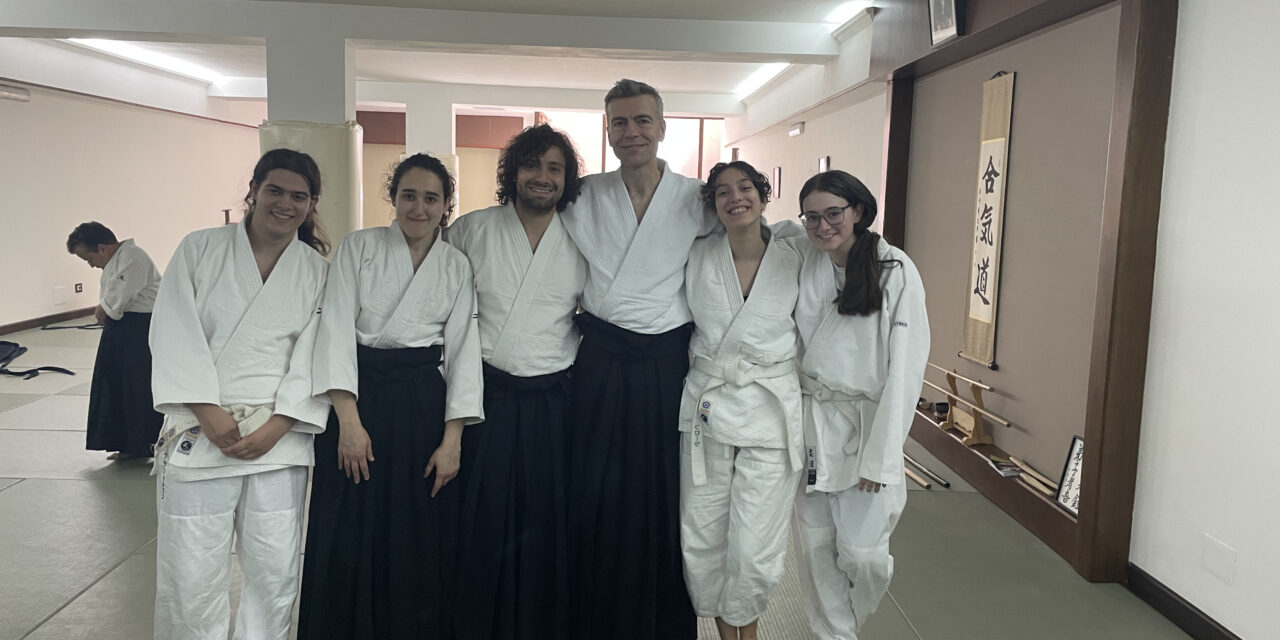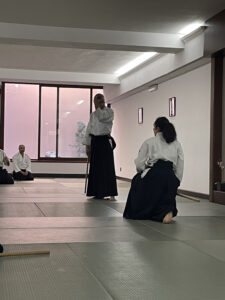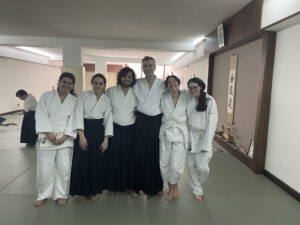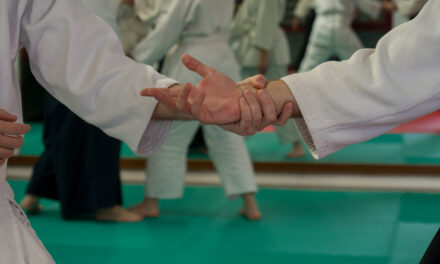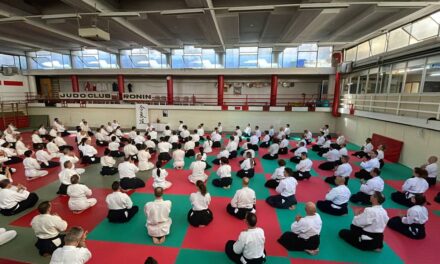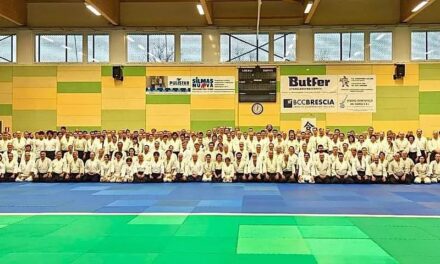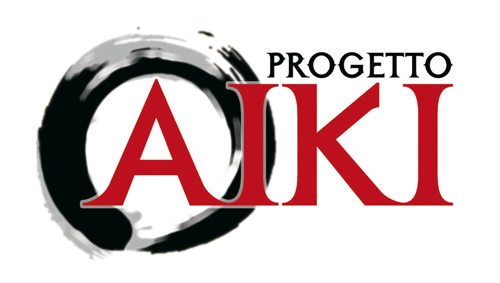Another workshop out of town, this time in Casagiove, in the province of Caserta.The teacher holding the seminar is Christophe Depaus, Belgian, whose background in aikido is nothing short of enviable: among his supporting teachers in his first years of practice there was Sugano Shihan, until he got in touch with Christian Tissier Shihan in 2000. The latter became one of his main instructors after departing from Sugan Shihan. Depaus has in turn been teaching while also running his own dojo in Bruxelles, named Ren Shin Kan, together with Valentina Perazzini. She is a determined, energetic, well-prepared Aikido practitioner: in short, the practice companion that everyone would like to have!
The workshop was organized by three ProgettoAiki associations, the Motus Academy of Salerno, the Marici Dojo of Caserta, and the Kyokan Dojo di Salerno. We should not talk about associations though, since we should focus on the faces of those who came, of those we can call friends: Alessio, Alessandra and Silvio, whom I sincerely thank.
It is after this brief introduction that the story of this seminar starts. On Friday the 10th of May it is hot outside while I go from university to Flora’s house, where I left my luggage. It contains both my keikogi and many other clothing items since the variability of the weather makes it difficult to know what to wear in advance. After quickly eating some pasta with zucchini, Flora and I take the tramway to join Giulia and Francesco, two of our toughest Aikido companions. We then take the bus to Caserta, where Alessandra Scialla, welcoming and well-prepared, is waiting for us. We are soon informed that the bus will be two hours late though, so we just wait without losing our smiles, but a bit anxious about the journey that awaits us. Therefore, we chat and laugh until the bus arrives, then we put our luggage in the special compartment and take our places. In the meantime, Elisa, another girl from our dojo, will be coming by car for leisure and meet us later on for the workshop.
After five hours and a half, we finally arrive to Caserta, where we are welcomed by Alessandra and meet Andrea. He trains in Amsterdam, but he took the workshop as an opportunity to come back to Italy and spend some time with us. However, we almost immediately go to sleep after drinking some limoncello because of the early ring of the alarm clock the following morning. As a matter of fact, we wake up at 7.45 a.m., take a shower and drink a cup of coffee, which is short, dense, dark as an abyss. That’s how it’s made in the South of Italy and it’s perfect, exactly how I like it. Time flies and it’s finally time to go, so we come back to the dojo to get ready. We soon meet Christophe, Valentina and Alessio, to whom we say hello warmly (especially Alessio because of our friendship), then we stretch, and the seminar starts.
We begin by focusing on the tegatana, especially on the Kokyu Nage and the hands gestures that, combined with the tension generated by the tori’s body and arms, lead to strong, dynamic projections which are also elegant, just like Christophe’s Aikido. We also tackled the version of Ikkyo, often talked about by Tissier, in which the shoulder becomes crucial to accomplish movements which would otherwise be impossible. If Ikkyo and Kokyu Nage, the hands become the lowest common denominator as far as these two principles are concerned as they must be as precise as a blade forged by a nimble artisan. This is what I learnt from Christophe Depaus during the first part of the seminar.
After that we had a break, during which I talked to Alessio about several topics, not necessarily related to Aikido. We also practiced falling to give each other some friendly feedback before having to wear both keikogi and hakama again. That’s when we start working on what Christophe calls a “kata of seven jo movements”. Being this one his story to tell I will avoid giving too many details, despite how moved I felt when he told us about it. I indeed believe that certain stories must be experienced as it happened to Christophe, so I will simply explain that this kata gathers most of the principles to apply when using the stick, from Gedan to Hasso.
I also enjoyed being called to be the uchijo, but what made me smile the most was the moment during which Giulia was designed to act as an uke. Students are like a teacher’s business card and hence pride always arises whenever they get some remarkable result, which happened to Flora in Berlin and Brescia with Tissien Shihan and to Francesco in Brescia with Christian Tissier.
As soon as this part of the seminar is over, taijutsu comes into the spotlight. In this case, the tori has to act peripherally on the uke by using both their hands with synergy: from Ai Hanmi Katate, one hand focuses on the elbow and hence on the hip (which is the actual objective), while the other hand makes it possible to accomplish the technique. When we pass to Ikkyo, though, we must pay attention to a change in the hands which requires a lot of dexterity and focus, which means we go from an internal to an external work. This means that, from Ai Hanmi K. Shiho Nage, we make the execution more rapid by using just one hand. The following movement is a Yokomen Uchi Kaiten Nage, done by rotating behind the uke after calling off the attack.
As far as the last day of the workshop is concerned, Sunday, both bokken and tegatana were considered. The former appeared as the classic version at first, but it consisted in contact work since the ken tai ken focuses on the kata with which uketachi cuts. In the meantime, shitaki takes the place of the wooden sword through the so-called ken. The movement is then directed upwards until the two uketachis attack Shomen by rotating the hip to be in front of their training companion. Shitaki then reacts to the second Shomen with a cut in Gyaku. That’s already a lot of work, but it’s not enough yet.
As a matter of fact, the last part of the seminar still must be introduced. We start by Chudan Tsuki, which needs the tori’s reaction to the uke’s attack. Such a technique involves an Okuri Ashi and a Kaiten, which will help take space to control the companion’s movements thanks to the rotation of the hand. An insight on Sankyo Ura, which is beautiful and never banal, follows. I do indeed encounter some difficulties and hence Christophe reexplains the technique to me so that I can execute it correctly. Only then do I understand clearly, so I smile to him and say: “Now I get it! I must act like an ideal gas! Pressure and volume equal moles, R, and temperature”. Christophe understands what I mean and laughs.
Sometime later, I am asked to be the uke. I consequently attack Chudan, who undoes my movement by acting on my shoulder with the tegatana, which kind of looks like a clash even though it isn’t. He then executes Shiho Nage and I feel as if I’am floating because of Christophe’s height. After that, I train with Valentina before we tackle the last subject of the seminar: Jodan Tsuki Kaiten Nage Ura, for which the movement of the hand has to level out uke’s arm.
The time spend practicing together made me smile. Not only was indeed the level high, but the pace of the workshop was rapid, and I could reap the benefits of my work. We unluckily had to part from each other, but we will meet Christophe again in Milan, where Miyamoto Shihan’s workshop will take place. Anyway, all the practitioners from Pistoia have one last thing to do, which is having lunch with Alessandra and Andrea before leaving. Once again at Alessandra’s place, we eat spaghetti with tomato sauce, cheese, vegetables and freshly homemade onigiris, which are accompanied by wine and beer. Such a delicious meal prepared by an extraordinary host, which corresponds to the idea of hospitality expected from the South of Italy. As a matter of fact, Alessandra gave us everything we could ever need, and I whole heartedly thank her for this.
I also thank Alessio, who always gives me great advice to help me overcome my limits, and Silvio, who gave us both hard work to do and friendship and cheerfulness. Thank you, Christophe, for everything you taught us thanks to your knowledge of Aikido, and Valentina. I’d like to thank Salvatore and every single one of the people we met in the dojo too, since they welcomed us and practiced with us. And finally, thanks to my students, who are always ready to learn something new and thirsty for knowledge. They are not simple there physically, on the tatami, they are also there with their hearts and do their best no matter what. They are the reason why I always try to improve; they are like fuel to formation.
Greetings to all and see you soon!
Alessandro
Thanks to Elisa Meloni who translated properly this article.

